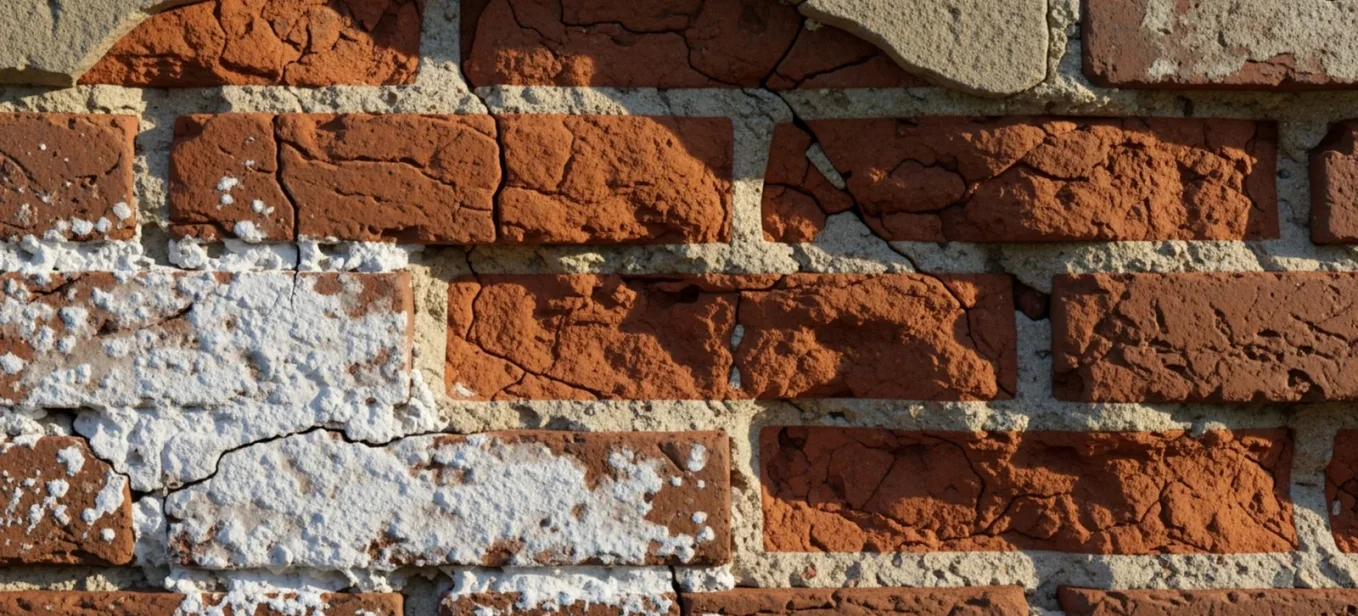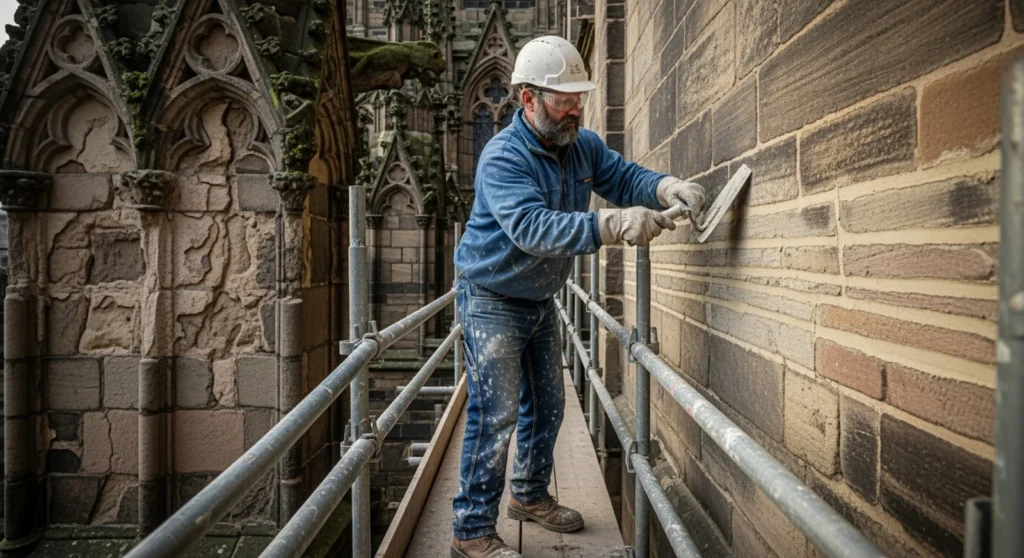
Understanding Masonry Restoration: Steps, Benefits, and When It's Needed
- By: Nova Construction Team
- Published:
- Updated: December 19, 2025
Masonry restoration is the careful process of repairing damaged masonry. A professional masonry restoration expert brings an old masonry structure back to its original look or condition.
This restoration project includes a range of jobs, such as cleaning, fixing cracks, replacing cracked or chipped bricks or stones, repointing deteriorated mortar joints, and fixing hidden structural problems.
The main goal is to make old structures stronger, safer, and better looking.
This type of masonry work helps buildings last. It keeps their historical and architectural integrity. It makes them look better, too.
Restoration services can be done on houses, churches, or well-known historic sites.
What Does Masonry Restoration Include?
Professional masonry restoration isn’t just a quick fix. It goes deep into understanding how a masonry structure was built.
A masonry restoration expert checks what needs repair. Then they use special methods to fix it. This process requires experience, careful work, and knowledge of both old and new building styles.
The jobs involved can be simple or complex. There is no single way to do it. Instead, the approach is chosen based on what the specific restoration project requires.
The repairs should work well and match the original construction look and materials of the building.
How Is Masonry Restoration Different From Masonry Repair?
Understanding the difference between masonry repair and restoration is crucial for home and business owners. Here’s how to tell the difference:
| Masonry Repair | Masonry Restoration | |
|---|---|---|
| Scope | Fixes small or local damage (like a few cracks or broken bricks) | Fixes larger areas, often bringing the whole building back to its original shape or appearance |
| Purpose | Deals with urgent or obvious issues | Takes care of both visible and hidden problems, including those that affect the whole building |
| Technique | Quick repairs | Uses special materials and methods, especially for historic sites |
Masonry repairs vs restoration often comes down to scope. Repairs are often smaller fixes. Restoration involves comprehensive work on deteriorating masonry.
Professional masonry restoration addresses wear and tear across the entire structure.
Main Types of Masonry Restored: Brick, Stone, and Concrete
- Brick Masonry: Brick is frequently used because it looks nice and is strong. However, brick and mortar can soak up water and crack due to environmental factors. A masonry contractor takes care of cleaning, fixing cracks in the mortar, and replacing damaged masonry. Timely restoration prevents water damage and maintains energy efficiency.
- Stone Masonry: Hard stone like granite is less likely to get water damage. Stone masonry is often found in foundations. Professional masonry restoration means careful cleaning, repair, and matching new high-quality materials to the existing masonry.
- Concrete Repair: This material is strong, but concrete can crack or deteriorate over time. Masonry work here may include patching cracks and adding coatings. Using high-quality materials helps extend the lifespan and improves longevity.
How Do I Know When Masonry Restoration Is Needed?
It’s important to notice damage early in your masonry structure. Waiting too long can cause small problems to escalate into major structural issues. These become more expensive to fix.
Spotting these signs early can help keep your building safe and looking good. Masonry restoration ensures the structural integrity remains intact.
Warning Signs That Masonry Needs Restoration
- Cracked or falling-out mortar between bricks or stones.
- Bricks or stones that are flaking or chipping away (often from freeze-thaw weather cycles).
- White, powdery deposits or water stains on the walls (called efflorescence).
- Metal parts, like lintels, that are rusting or starting to bow.
- Stains, mold, or plant growth on the masonry, showing trapped moisture.
Why Waiting Can Make Problems Worse
- Water can get in through cracks, freezing and causing more damage.
- Walls and supports can lose strength, leading to more serious safety risks.
- Delaying repairs can make energy costs go up due to air leaks.
- It costs more to fix a badly damaged building than to handle small repairs early.
Special Care for Historic Buildings
Historic buildings often require restoration using specialized approaches. Commercial properties with historical significance need particular attention. Swapping old materials for new ones can sometimes cause more harm than good.
Using materials that match the original construction is important for keeping the building sound. Using incorrect new mortar or stone can speed up deterioration.
Restoration often needs to match the old methods and materials used as closely as possible. A masonry restoration expert understands these requirements.
Main Steps in Masonry Restoration
1. Inspection and Assessment
A professional masonry contractor starts by carefully checking the building. They find all the issues — cracks, crumbling mortar, stains, bulges, or loose materials. The causes of the damage are also found at this stage.
Environmental factors, weather, settling, and past repairs are evaluated. This helps determine if the masonry may require restoration or just repair.
2. Cleaning and Preparation
The area is cleaned to remove dirt, mold, and loose pieces. Sometimes pressure washing is used, sometimes cleaning is done by hand. Care is taken to use the right cleaning method for each material.
3. Repointing and Mortar Repair
Old, deteriorated mortar is scraped out and replaced. This prevents water from getting in through gaps. New mortar is carefully matched to the original.
“Tuckpointing” is when a thin layer of mortar is added. This makes the joints look neat and uniform. Professional masonry restoration ensures proper mortar matching.
4. Fixing Cracks, Stains, and Water Damage
Cracks are filled using proven techniques. Stains are cleaned from the masonry structure. Areas with water damage undergo restoration.
Sometimes special grouting techniques are used for larger projects. This masonry work helps prevent water infiltration.
5. Replacing Bricks or Stones
Badly damaged bricks or stones are removed. They’re replaced with new ones that look and act just like the originals.
A mason carefully matches materials used in the original construction. This maintains the architectural integrity of the masonry structure.
6. Applying Waterproofing and Protective Coatings
After repairs, sealants or water-repelling coatings are added. These help prevent water from getting in and causing future damage. High-quality materials are used to ensure longevity.
7. Restoring Decorative Details
Architectural designs and features are repaired or recreated. A masonry restoration expert sometimes uses modern technology. It allows them to match historic looks while maintaining structural integrity.
What Are the Main Benefits of Masonry Restoration?

- Stronger and Safer Building: Structural repairs keep buildings safe for people using them. Professional masonry restoration helps prevent accidents or collapses. The restoration process maintains the structural integrity of the building.
- Better Waterproofing: Sealing up cracks and using water-resistant coatings keeps out moisture. This reduces the risk of future masonry deterioration. Timely restoration prevents costly water damage.
- Brings Back Original Look: Cleaning and matching repairs help restore the original color and finish. The masonry structure looks new again. Architectural integrity is preserved through careful restoration.
- Removes Mold and Stains: Cleaning gets rid of health hazards like mold. It removes ugly stains and buildup from the building’s masonry. This improves both appearance and air quality.
- Raises Property Value: A neat, safe, and attractive exterior increases a building’s selling price. It makes a better impression on visitors or buyers. Business owners benefit from enhanced curb appeal.
- Environmentally Friendly: Fixing old buildings uses fewer new materials. Professional masonry restoration creates less waste than tearing down and rebuilding. This approach is more cost-effective and sustainable.
- Improved Energy Efficiency: Proper restoration seals gaps and cracks. This reduces air leaks and improves the building’s energy efficiency. Home and business owners see lower utility costs.
Frequently Asked Questions
How Often Should I Restore Masonry?
It depends on your masonry structure, weather, and maintenance. In tough climates with lots of freezing and wet weather, problems can come up faster due to environmental factors. Small masonry repairs could be needed every 20-30 years. A major restoration project might only be needed every 50 years or more.
Regular inspection of your building’s masonry is the best way to catch problems early. Checking your masonry structure every year helps prevent small issues from becoming more significant problems.
Will Insurance Pay for Restoration?
Sometimes insurance will help pay for masonry restoration services. This is especially true if the damage was caused by something sudden — like a fire, storm, or vandalism. Most policies don’t pay for issues caused by normal wear and tear or neglect.
It’s best to ask your insurance company and look over your policy first. Keeping good records can help if you need to file a claim. Document the need of repair when damage occurs.
How Much Does Masonry Restoration Cost?
The price can change a lot depending on several factors. The size of the restoration project matters. The kind of masonry structure also affects cost.
Minor masonry repair involves costs of a few hundred dollars. Fixing whole walls or major cracks might cost thousands or even tens of thousands of dollars.
Catching and repairing problems early is usually much more cost-effective than waiting until things get worse.
Got a project in mind? Let's chat about bringing your construction vision to life!
